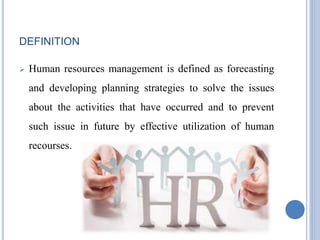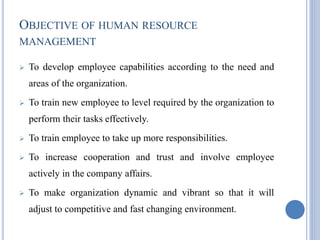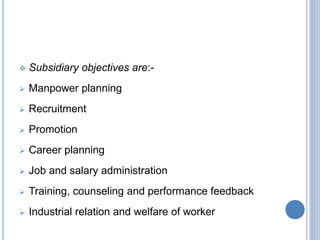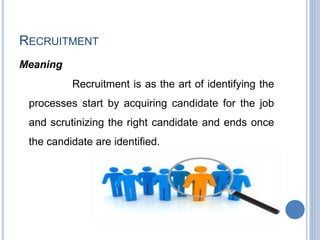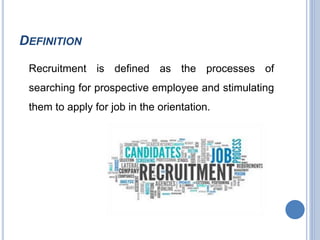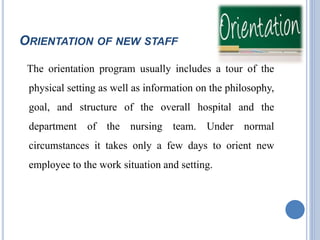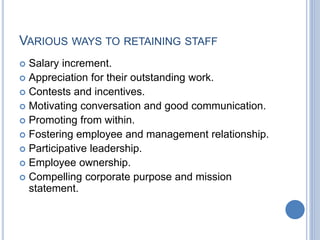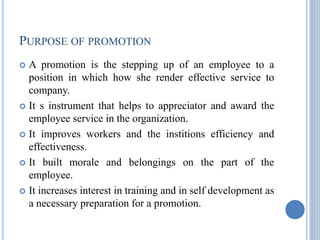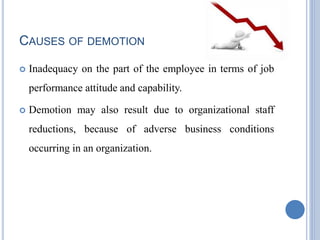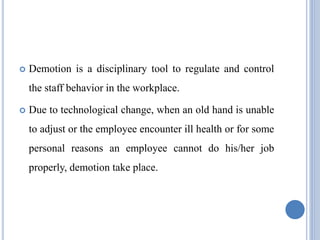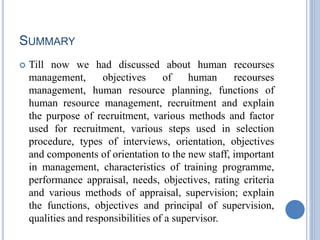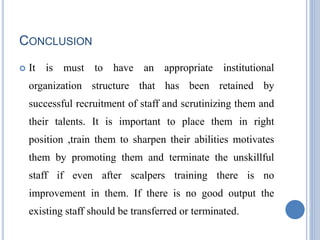Human resources
- 1. HUMAN RESOURCES Mr.Vikas Anil Ghadge RJS College of Nursing
- 2. DEFINITION Human resources management is defined as the activity in there management that is concerned with the intelligent utilization of human recourses to achieve goal of management. Yoder
- 3. DEFINITION Human resources management means seeking, identifying, selecting, appointing, training and utilizing selected worker to manage the resources to meet the goals of management. F.F.I.French
- 4. DEFINITION Human resources management is defined as forecasting and developing planning strategies to solve the issues about the activities that have occurred and to prevent such issue in future by effective utilization of human recourses.
- 5. OBJECTIVE OF HUMAN RESOURCE MANAGEMENT To make personal acquire power to perform the different types of work that may come in there way at present or in future. To develop hidden talent of individual workers that may be used for the development of the organization. To provide and opportunity for employee to grow and to strengthen the management and professional team in all the areas of the organization.
- 6. OBJECTIVE OF HUMAN RESOURCE MANAGEMENT To develop employee capabilities according to the need and areas of the organization. To train new employee to level required by the organization to perform their tasks effectively. To train employee to take up more responsibilities. To increase cooperation and trust and involve employee actively in the company affairs. To make organization dynamic and vibrant so that it will adjust to competitive and fast changing environment.
- 7. Subsidiary objectives are:- Manpower planning Recruitment Promotion Career planning Job and salary administration Training, counseling and performance feedback Industrial relation and welfare of worker
- 8. HUMAN RECOURSES PLANNING Human resource planning is the act of deciding on the required number of worker to meet the requirements in order to carry out the incorporated plans of the institutions. P.Bruce Colemn
- 9. FUNCTIONS OF HUMAN RESOURCE PLANNING It establishes healthy relationship between management and workers and between the workers themselves. It is a reciprocal activity whereby the management in turn understands the workers through the HRM processes. It creates a congenial work environment to motivate workers to work in a relaxed way. It provides a base for employee to become knowledgeable and positive in their work.
- 10. CONT… It increases the organizational efficiency and workers productivity by adopting motivating and instituting welfare measure for employees. It makes employees identify themselves with the organization and get a senses of accomplishment through their work. It maintains the morale of employee on a high plane. It reduces militancy and harsh thinking among workers and promotes industrial peace.
- 12. RECRUITMENT Meaning Recruitment is as the art of identifying the processes start by acquiring candidate for the job and scrutinizing the right candidate and ends once the candidate are identified.
- 13. DEFINITION Recruitment is defined as the processes of searching for prospective employee and stimulating them to apply for job in the orientation.
- 14. TYPES OF RECRUITMENT There are three types of recruitment 1. Planned arise from changes in organization and recruitment policy. 2. Anticipated by studying trends in the internal and external organization. 3. Unexpected arise due to accidents, transfer and illness.
- 15. SOURCES OF RECRUITMENT 1. Internal sources/direct sources Internal sources include present employee, employee referrals, former employee and former applications.
- 16. 2. External sources/indirect source Sources external to an organization are professional or trade associations, advertisements, employment exchange, college/university /institute placement service, walk in and writer, consultants, contractors.
- 18. IMPORTANCE OF RECRUITMENT Recruiting the right candidate who will work for a given period of time and may exit the institution if their performance is not good, or may be retained if their performance is good. Selecting candidates based on the social and legal obligation framed by the organization selecting component candidates from the pool candidate. Identifying the competency status of differently recruiting sources and procedure to find the right candidate.
- 19. Helping in the prevention of overlapping of highly qualified candidate with those with below per qualification. Enabling to analyze the needs for recruitment of candidates for future requirement. Handling a group of candidate at low expenditure. Achieving the institutional goals in short and long term by recruiting right number of candidates.
- 20. FACTORS DETERMINING RECRUITMENT Size of the business. Employment condition in the locality of recruitment. The past recruiting policy of the organization in retuning good workers. The rate of growth of the organization, future, cultural, legal; and economic factors.
- 21. RECRUITMENT POLICY This provides a framework for recruitment and contains aspect such as:- Organizational objective Identification of the recruitment needs Preferred sources of recruitment Criterion of selection and preference The cost of recruitment and financial implementation
- 22. MANPOWER FORECASTING This process is as follow:- Receive employee indent from line staff which contain vacant positions tenure of employment salary offered etc. Check the indent against the allotted posts of each department Check financial implications for proposed recruitment Find out whether the recruitment is within the budgetary sanctions of the concerned departments. Authorize the proposed recruitment with job specifications and salary details.
- 23. METHODS OF RECRUITMENT Transfer: the transfer denotes the changing of an employee from one job to another with measure modifications in the status and responsibilities of the employee. Promotion: this includes shifting of an employee to a higher position with higher responsibilities higher status and money pay. Advertisements: another very popular source of recruitment is advertising in trade and professional journals or news paper.
- 24. Employment agencies: the government of India has set up network of employment exchanges throughout the country .These exchange maintain details record job seekers and refer appropriate candidates to the relevant employers. Educational institutions: for marginal and technical professional’s job, institutions and colleges of management and technology have become a popular source of recruitment. Recommendations: applicants introduced by present employee or their friends and relatives may prove good source of recruitment.
- 25. Causal callers: many well ruptured business organization draw a study stream of unsolicited applications in their offices. Direct recruitment: under these sources of recruitment a notice is placed on the notice board of the enterprise specifying the details of the job available. Labor contracts: maintain close contracts with labors and they can provide the require number of worker at short notice.
- 27. PLACEMENT Placement may be defined as the determination of the job to which an accepted candidate is to be assigned and his/her assignment to that job. It is a matching of how the supervision has reason to think a candidate can handle the job demands it is matching of what he/she imposes and what he/she offers in the form of payroll, companionship with others, promotional possibilities, etc. a proper placement of workers reduce employee turnover, absenteeism and accident rates, and improves morale.
- 28. EFFECTIVE PLACEMENT Placement can be defined in following ways:- 1.Job rotation: this enables an employee to satisfy his/her aptitude for challenging work. 2.Teamwork: this allow employee to use their skills, knowledge, etc. thereby minimizing the problems in placement. 3.Training and development: continuous training and development program help employee to acquire new skills and knowledge.
- 29. CONT… 4.Job enrichment: this gives the opportunity of utilizing the varied skills of the employee and minimizing problems in management. 5.Empowerment: empowering employee’s makes the employee makes the employer exploit their potentialities and most effectively make use of them.
- 30. ORIENTATION OF NEW STAFF The orientation program usually includes a tour of the physical setting as well as information on the philosophy, goal, and structure of the overall hospital and the department of the nursing team. Under normal circumstances it takes only a few days to orient new employee to the work situation and setting.
- 31. OBJECTIVE OF ORIENTATION To support the new employee during the traction period of the assigned area. To assist the new employee in identifying individual strength and weakness. To furnish and introduction retrospections of basic skills and picked out learning experiences on the basis of individual requirement. To act as channel of communication between the staff and the employee helping and supporting the staff to take part in educating the new employee. To furnish current assessment of the new employee performance during orientation via the regular planned meetings.
- 32. COMPONENTS OF ORIENTATION PROGRAMME Aims and principal underlying the hospital and its units. Organizational policies. Personnel policies. Clinical policies. Administrative policies Relationship between various department and personal. Standard of nursing practice Physical facilities Records Educational opportunities.
- 33. Legal and ethical responsibilities. Infection control policies. Emergency response procedures. Evaluating procedures.
- 35. TRAINING Training is an activity which involves the development of hidden talent of an individual and using it for the organization .it is directed towards maintaining and improving current jobs and developing skills in employee for future job .after the candidates are selected for various job, there is a need for the management to provide for the training and development which is essential for the efficiency of an organization.
- 36. REASON FOR TRAINING To increase the use of technology To minimize labor turnover. To increase the productivity of an employee. To enable employee to keep abreast of the changing method, technique and use of sophisticated tools and equipment. To manage time efficiency. To raise the morale of an employee.
- 37. IMPORTANT OBJECTIVE OF TRAINING To provide basic knowledge and skills to new employee to perform the task designed by the organization. To develop the capabilities of existing employee by exposing them to latest concept information and technique and thereby strengthen their skills. To develop second and third line executive to strengthen there working links and level so that they can occupy higher position.
- 38. CONT… To improve the outlook of senior level managers and other policy makers enabling them to look to future prospects for the organization. To make employee more effective and productive thereby increasing their earning power and ensuring job security. To mould employee attitudes with the purpose of achieving better cooperation with the company and develop loyalty to organizations.
- 39. CHARACTERISTICS OF TRAINING PROGRAM Allowance for individual difference. Relevance for job difference. Determination of training needs. Training program should be result oriented.
- 40. STAGES OF TRAINING Discovering or identifying training need Getting Ready For the Job Preparation of the Learner Presentation Of Operations And Knowledge Performance Tryout Follow Up
- 41. STAGES OF TRAINING TRAINING CYCLE IDENTIFY NEEDS DESIGN TRAINING DELIVER TRAINING EVALUATE TRAINING
- 42. BENEFITS O TRAINING If an individual is trained there will be a natural increase in skills which will show in both the quality and quantity of output. Training heightens the morale of the employee by imparting confidence and motivation to attempt new tasks. Trained employee can perform their work with little or no supervision. It makes the job easier and gives the employee and the supervisor great independence. Many accidents occur because of the deference in people rather than deficiencies in equipment and working condition. Trained employee will always be careful while performing their job
- 43. CONT… Trained employee can relate the present to future requirements of a task to maintain quality performance. Training facilities a deeper and better conceptual understanding and built cohesiveness in a group. Training makes better communication between individual and groups. Training provides information on government legislations and other administrations.
- 44. STAFF DEVELOPMENT Staff development is a systemic and organized way of introducing the staff member into an activity processes or into a particular working area in an organization.
- 45. THE OBJECTIVE OF DEVELOPMENT IN NURSING To become familiar with policies standards and protocols of an institutions. To install confidence to carry out the duties and responsibilities. To maintain smooth and systematic functioning of the working unit. To provide quality nursing care to patient.
- 46. To maintain professional standard in the workplace. To manage emergency situations. To keep the nurses equipped with optimum knowledge and skills To make use of available resources to provide the best care to the patients. To deliver the patient care equally and uniformly.
- 47. EFFECTIVE DEVELOPMENT OF STAFF The staff distribution in the any school or any firm should be as per the rules and regulations. Effective development increases virtuousness among the worker which leads to good output and increases profits in an organization. It provide a competitive edge for attracting and retaining highly efficient staff.,
- 48. CONT… Right distribution of staff in right place reduces higher level of stress and conflict among the staff and the management. It provides higher level of productivity and output, thereby promoting the social status of the staff organization.
- 49. ADVANTAGES OF STAFF DEVELOPMENT The area of the development should be selected based on the competency of the staff. The worker gives good work output since their skills are matched as per their interest and ability. No duplications of the work is possible.
- 50. CONT… There will be no interruption in work mode by staff in any case. Staff has a since of belonging and a right mind to work with team spirit. Unnecessary expenditure is avoided.
- 51. EFFICIENT MODE OF STAFF DEVELOPMENT Framing the staff policies, rules and regulations. Evaluation of staff activity and performance Identifying the area of excellence where the staff distribution can be done effectively. Staff oriented activities are planned since the out of the organization depends on the staff performance.
- 52. CHECKLIST FOR EFFECTIVE DEVELOPMENT Total number of current staff. Find the performance level of the staff deployed. Delayed the highly efficient staff in the challenging work environment. Adequate supplies and fulfilling other requirements ensure good working environment the staff. Motivate them by rewarding the best performance. Pullout the weed that affects the outputs there should be continuous evaluation of the staff performance in order to have efficient development.
- 53. RETAINING STAFF The quality of care depends on the quality staff members present in the unit retaining staff is very important for the smooth functioning of an organization.
- 54. VARIOUS WAYS TO RETAINING STAFF Salary increment. Appreciation for their outstanding work. Contests and incentives. Motivating conversation and good communication. Promoting from within. Fostering employee and management relationship. Participative leadership. Employee ownership. Compelling corporate purpose and mission statement.
- 55. ADVANTAGES It helps to save man, money, material and time. It helps to save the advertisement, recruitment, orientation and training expenses. I increase the productivity of an organization. It maintains the smooth functioning in the working environment.
- 56. STAFF PROMOTION Promotion is defined is an improvement in worker position with more accountable better status and higher pay along with increased responsibilities in the job environment.
- 57. FACTORS IMPLYING PROMOTION Factors Implying Promotion Increase In Salary Increase In Prestige Upward Movement in Job Superviso ry Responsib ility Better Future
- 58. PURPOSE OF PROMOTION To groom the law abiding workers, instilling feelings of virtuousness, belongingness and trust worthiness among the employees so that they deserve. To encourage good working environment so as to provide good job satisfaction and give them an opportunity for succiveness service. To retain the competent workers in the organization. To encourage the selective socialization.
- 59. CONT… To recognize and appreciate the individual skill they helps in giving quality output and which motivates the employee to work harder. To create a feeling of satisfaction and success in the organization. To improve the social status and image of the labor. To avoid transfer or terminations since all workers strive for getting promotions
- 60. DIFFERENT KINDS OF PROMOTION This is multi promotional mode of getting a chance to acquire higher position; it has a systemic connection from entrance to exist with clearly defined guidelines. Another type is seeking either promotion or employment elsewhere. Still another type gives dry promotion wherein instead of increasing the wages of the personnel will be promoted to higher position.
- 61. PURPOSE OF PROMOTION A promotion is the stepping up of an employee to a position in which how she render effective service to company. It s instrument that helps to appreciator and award the employee service in the organization. It improves workers and the institions efficiency and effectiveness. It built morale and belongings on the part of the employee. It increases interest in training and in self development as a necessary preparation for a promotion.
- 62. DEMOTION Demotion is a shift to a position in which responsibilities are decreased.
- 63. CAUSES OF DEMOTION Inadequacy on the part of the employee in terms of job performance attitude and capability. Demotion may also result due to organizational staff reductions, because of adverse business conditions occurring in an organization.
- 64. Demotion is a disciplinary tool to regulate and control the staff behavior in the workplace. Due to technological change, when an old hand is unable to adjust or the employee encounter ill health or for some personal reasons an employee cannot do his/her job properly, demotion take place.
- 65. DEPLOYMENT POLICIES AND PROTOCOLS Every institution should have disciplinary protocols and policies to regulate the employee behavior. Every institution should have a disciplinary committee to formulate the disciplinary rules and regulations. The disciplinary committee should maintain discipline and monitor the disciplinary condition and organizations. In case of any violation, through investigation needs to be done before giving any punishment. There should be periodical revision and modification in the disciplinary rules and regulations.
- 66. SUPERANNUATION Is a retirement fund or pension gives to the employee at the time of retirement every organization has a plan of superannuation for their employee. It is also a basic right of the employee to be paid for by the employer or the organization for their sincere hard work or service rendered to the institution.
- 67. BENEFITS OF SUPERANNUATION It helps the employee to plan for their future life. It motivates the current working employees to work efficiency. It the additional amount paid by the employee for the sincere service rendered by the employee. It reflects the institutional or organizational image.
- 69. SUMMARY Till now we had discussed about human recourses management, objectives of human recourses management, human resource planning, functions of human resource management, recruitment and explain the purpose of recruitment, various methods and factor used for recruitment, various steps used in selection procedure, types of interviews, orientation, objectives and components of orientation to the new staff, important in management, characteristics of training programme, performance appraisal, needs, objectives, rating criteria and various methods of appraisal, supervision; explain the functions, objectives and principal of supervision, qualities and responsibilities of a supervisor.
- 70. CONCLUSION It is must to have an appropriate institutional organization structure that has been retained by successful recruitment of staff and scrutinizing them and their talents. It is important to place them in right position ,train them to sharpen their abilities motivates them by promoting them and terminate the unskillful staff if even after scalpers training there is no improvement in them. If there is no good output the existing staff should be transferred or terminated.




